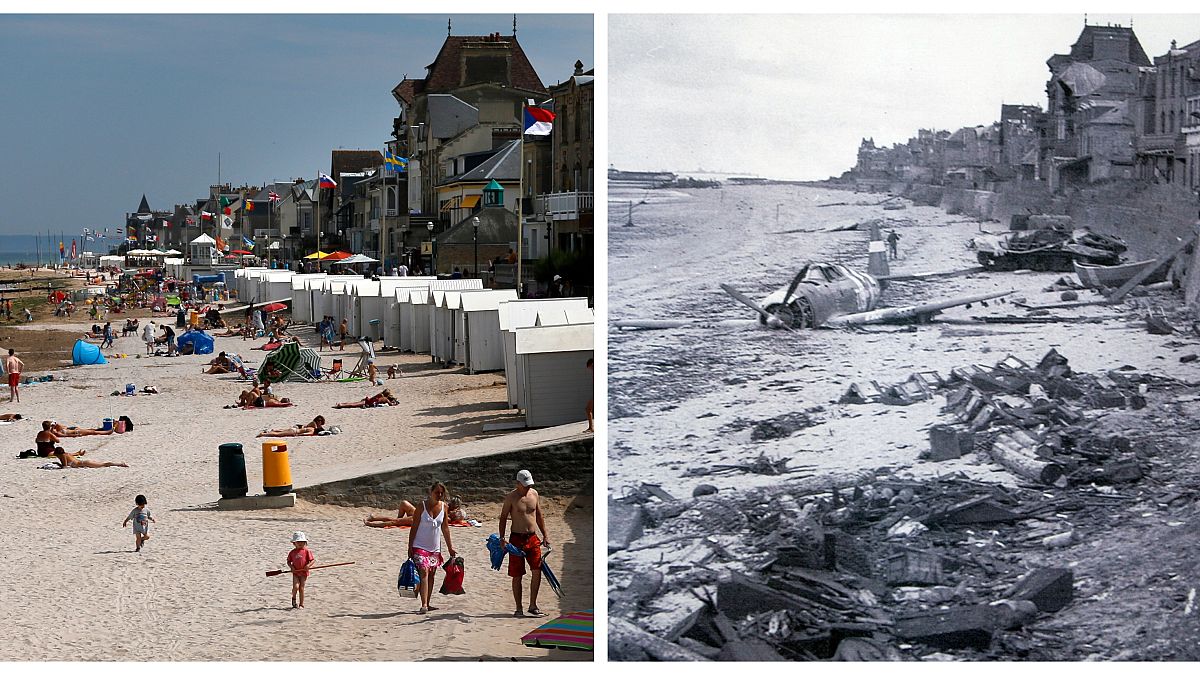As Europe pays tribute to the fallen, photographer Chris Helgren returned to some of the key locations involved in the D-Day landings to see how they have changed since the war.
June 6 marks 75 years since D-Day, the huge seaborne invasion that marked the beginning of the end of World War II.
It was the largest combined land, air and naval operation in history when over 150,000 soldiers from the UK, US, Canada and France landed on the beaches of Normandy.
As Europe pays tribute to the fallen, photographer Chris Helgren returned to some of the key locations involved in the D-Day landings to see how they have changed since the war.
Pull the vertical white bar left and right across the images below to compare how various locations looked then and now.
Weymouth, England
The righthand picture shows tourists walking along the beach-front in the Dorset holiday town of Weymouth, England on July 13, 2013. The port was the departure point for thousands of Allied troops who took part in the D-Day landings.
The 2nd Battalion US Army Rangers, tasked with capturing the German heavy coastal defence battery at Pointe du Hoc to the west of the D-Day landing zone of Omaha Beach, can be seen in the left photo marching to their landing craft in Weymouth, England, on June 5, 1944.
Bernieres-sur-Mer, Normandy, France
A tourist can be seen in the photograph on the left, taken in 2013, sunbathing on a former Juno Beach landing area where Canadian troops came ashore on D-Day at Bernieres Sur Mer, France.
On the right, German prisoners-of-war march along Juno Beach landing area to a ship taking them to England, after they were captured by Canadian troops on June 6, 1944.
Omaha Beach, Saint-Laurent-sur-Mer, Normandy, France
On the right, US Army troops congregated around a signal post used by engineers on the site of a captured German bunker overlooking Omaha Beach after the D-Day on June 7, 1944.
Tourists can be seen on the left walking past the same German bunker in 2013.
Place du Marché, Trévières, Normandy, France
In a handout photo provided by the US National Archives (right) the body of a dead German soldier can be seen lying in the main square of Place du Marche after the town was taken by US troops who landed at nearby Omaha Beach in Trevieres on June 15, 1944.
Now, tourists walk across the main square and can be seen in this picture from August 23, 2013.
Rue Holgate and RN13, Carentan, Normandy, France
Girls run across the street at the junction of Rue Holgate and RN13 in the Normandy town of Carentan, France, June 21, 2013 (left).
Over 70 years earlier, US Army paratroopers of the 101st Airborne Division were photographed driving a captured German Kubelwagen on D-Day at the same junction.
Rue Saint-Pierre, Caen, Normandy, France
In the photo on the right from the National Archives of Canada, Canadian troops can be seen patrolling along the destroyed Rue Saint-Pierre after German forces were dislodged from Caen in July 1944.
British and Canadian troops battled reinforced German troops holding the area around Caen for about two months following the D-Day landings in Normandy.
Shoppers walk along the rebuilt street on August 23, 2013 (left).
Saint-Aubin-sur-Mer, Normandy, France
On the left, tourists enjoy the sunshine on the former Juno Beach D-Day landing zone, where Canadian forces came ashore, in Saint-Aubin-sur-Mer, France, August 23, 2013.
The photograph on the right paints a different picture, showing a crashed US fighter plane on the waterfront some time after Canadian forces came ashore.
